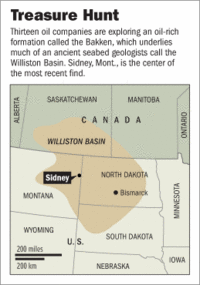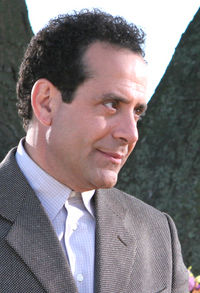(p. 390) Business success is less a function of grandiose predictions than it is a result of being able to respond rapidly to real changes as they occur.
Welch, Jack. Jack: Straight from the Gut. New York: Warner Business Books, 2001.
(p. 390) Business success is less a function of grandiose predictions than it is a result of being able to respond rapidly to real changes as they occur.
Welch, Jack. Jack: Straight from the Gut. New York: Warner Business Books, 2001.
 Source of image: WSJ article cited below.
Source of image: WSJ article cited below.
(p. A1) David F. Morehouse, senior geologist with the U.S. Department of Energy’s Energy Information Administration, contends there is more new oil to be found in the continental U.S. Finding it, he says, will “depend on people doing the data analysis and, quite frankly, people going in and drilling enough in the right places.”
Mr. Findley, who is 54 years old, did just that. Now production in this part of eastern Montana is growing, and new investors are arriving to explore the potential. At least one midsized firm, Marathon Oil Co., has begun buying leases. Halliburton Co., the big Houston-based oil-services company, has invested with Mr. Findley. The state says the proven oil find in the area will likely be in the range of 150 million barrels, hardly what oil-patch hands call an “elephant,” but nevertheless boosting the nation’s proven oil reserves by about 1%.
. . .
(p. A14) While many people associate big oil finds with big companies, over the years about 80% of the oil found in the U.S. has been brought in by wildcatters such as Mr. Findley, says Larry Nation, spokesman for the American Association of Petroleum Geologists. Wildcatters search for oil, nail down drilling rights, then seek money from banks or bigger companies to extract it.
Mr. Findley grew up in Corpus Christi, Texas, the son of an accountant for a chain of grocery stores. A brother-in-law, a geologist, hired him as a field assistant to hunt for oil in west Texas. “I just fell in love with geology,” he recalls. He graduated from Texas A&M University in 1975 and got a job as a geologist with Tenneco Oil Co. In 1983 he left to found his own Montana-based consulting and exploration company, a one-man operation.
Three years later, world oil prices crashed, and fluctuating prices dogged Mr. Findley as he tried to stay in the business. In the 1990s, the majors left the area in the belief that it was played out. Mr. Findley felt there was more oil to be found and began putting together small exploration deals.
His income had dropped by more than half to $45,000 a year, and he wasn’t sure how much longer that would last. “Many times, my wife and I sat down at the kitchen table and said, ‘What are we going to do next?’ We always came to the same conclusion. [Geology] is what I know. This is what I love. So we just kept going.”
For the full story, see:
JOHN J. FIALKA. “Second Look; Wildcat Producer Sparks Oil Boom On Montana Plains After Majors Pulled Out, Mr. Findley Drilled Anew; Size of Find Still Unclear; A Rival Counts Tanker Trucks.” The Wall Street Journal (Weds., April 5, 2006): A1 & A14.
 Source of map: WSJ article cited above.
Source of map: WSJ article cited above.
Vernon Smith, one of the 2002 recipients of the Nobel Prize in economics, advocates fundamental institutional reform:
Physicians and medical organizations face escalating administrative costs of complying with ever more detailed regulations. The system is overwhelmed by the administrative cost of attempting to control the cost of medical service delivery. In education, university budget requests are denied by the states who also limit the freedom of universities to raise tuition.
If there is a solution to this problem, it will take the form of changing the incentive structure: empowering the consumer by channeling third-party payment allowances through the patients or students who are choosing and consuming the service. Each pays the difference between the price of the service and the insurance or subsidy allowance. Since he who pays the physician or college calls the tune, we have a better chance of disciplining cost and tailoring services to the customer’s willingness to pay.
Many will say that neither the patients nor the students are competent to make choices. If that is true today, it is mostly due to the fact that they cannot choose and have no reason to become competent! Service providers are oriented to whoever pays: physicians to the insurance companies and the government; universities to their legislatures. Both should pay more heed to their customers — which they will if that is where they collect their fees.
For the full commentary, see:
VERNON L. SMITH. “Trust the Customer!” The Wall Street Journal (Weds., March 8, 2006): A20.
Has the United States lost its vitality? No. Americans remain the hardest working people on the face of the earth and the most productive. As William W. Lewis, the founding director of the McKinsey Global Institute, wrote, ”The United States is the productivity leader in virtually every industry.” And productivity rates are surging faster now than they did even in the 1990’s.
Has the United States stopped investing in the future? No. The U.S. accounts for roughly 40 percent of the world’s R. & D. spending. More money was invested in research and development in this country than in the other G-7 nations combined.
Is the United States becoming a less important player in the world economy? Not yet. In 1971, the U.S. economy accounted for 30.52 percent of the world’s G.D.P. Since then, we’ve seen the rise of Japan, China, India and the Asian tigers. The U.S. now accounts for 30.74 percent of world G.D.P., a slightly higher figure.
What about the shortage of scientists and engineers? Vastly overblown. According to Duke School of Engineering researchers, the U.S. produces more engineers per capita than China or India. According to The Wall Street Journal, firms with engineering openings find themselves flooded with résumés. Unemployment rates for scientists and engineers are no lower than for other professions, and in some specialties, such as electrical engineering, they are notably higher.
Michael Teitelbaum of the Alfred P. Sloan Foundation told The Wall Street Journal last November, ”No one I know who has looked at the data with an open mind has been able to find any sign of a current shortage.” The G.A.O., the RAND Corporation and many other researchers have picked apart the quickie studies that warn of a science and engineering gap. ”We did not find evidence that such shortages have existed at least since 1990, nor that they are on the horizon,” the RAND report concluded.
. . .
. . . , the American workplace is so competitive, companies are compelled to promote lifelong learning. A U.N. report this year ranked the U.S. third in the world in ease of doing business, after New Zealand and Singapore. The U.S. has the second most competitive economy on earth, after Finland, according the latest Global Competitiveness Report. As Michael Porter of Harvard told The National Journal, ”The U.S. is second to none in terms of innovation and an innovative environment.”
For the full commentary, see:
DAVID BROOKS. “The Nation of the Future.” The New York Times (Thursday, February 2, 2006): A23.

Source of image: http://www.usanetwork.com/series/monk/theshow/characterprofiles/tony/index.html#
“Monk” and “House” on the USA Network present suspenseful plots, and intelligent dialogue. But, more importantly, they present unusual “characters” for television: Monk and House are primarily concerned, not with their social standing or sex life, but with getting important jobs done–for Monk, solving murders, for House, curing diseases. One possible moral: maybe it’s OK to be intense in the service of a good cause?
An episode of ”Monk,” in which the title character — an obsessive-compulsive private eye played by Tony Shalhoub, below — suffered amnesia after a blow to the head, was the most-watched show on advertiser-supported cable for the week that ended Jan. 22, with an audience of 6 million. USA Network, where ”Monk” lives, was again the No. 1 basic-cable channel in prime time for that week. USA is also benefiting from reruns of the Fox medical show ”House,” which it began broadcasting earlier in the month: the ”House” that ran after ”Monk” on Jan. 20 attracted 3.79 million viewers.
Source:
KATE AURTHUR. (sic) “Arts, Briefly; ‘Monk’ Strong on Cable.” The New York Times (Mon., January 30, 2006): E2.
TORONTO, Feb. 19 – The cracks are still small in Canada’s vaunted public health insurance system, but several of its largest provinces are beginning to open the way for private health care eventually to take root around the country.
Last week Quebec proposed to lift a ban on private health insurance for several elective surgical procedures, and announced that it would pay for such surgeries at private clinics when waiting times at public facilities were unreasonable.
The proposal, by Premier Jean Charest, who called for ”a new era for health care in Quebec,” came in response to a Supreme Court decision last June that struck down a provincial law that banned private medical insurance and ordered the province to initiate a reform program within a year.
The Supreme Court decision ruled that long waits for various medical procedures in the province had violated patients’ ”life and personal security, inviolability and freedom,” and that prohibition of private health insurance was unconstitutional when the public health system did not deliver ”reasonable services.”
For the full story, see:
CLIFFORD KRAUSS. “Ruling Has Canada Planting Seeds of Private Health Care.” The New York Times (Mon., February 20, 2006): A4.
A COMPANY called Goodmail Systems thinks it has come up with a potential (and partial) solution to the problem of spam and fraud on the Internet. According to Goodmail, market forces are the answer, rather than the kinds of ineffective regulations that have so far failed to solve the problems.
. . .
What shocks me most about the opposition to Goodmail is that people who claim to believe in the free and open Internet, with its welcome attitude to innovation, want to shut down an idea. That’s wrong.
If people like those little stamps that mark their mail as safe and wanted or as commercial transactions, then let the customers have them. And let other companies compete with Goodmail to offer better and less expensive service.
Goodmail isn’t good because it’s new, but neither is it bad because it’s new. If it’s a good model, it will succeed and improve over time. If it’s a bad model, it will fail. Why not let the customers decide?
For the full commentary, see:
ESTHER DYSON. “You’ve Got Goodmail. The New York Times (Fri., March 17, 2006): A23.
A junior high school student in Idaho, Nathan Zohner, demonstrated in a 1997 science fair project how easy it was to hoodwink a scientifically uninformed public. As described in “The Frankenfood Myth,” 86 percent of the 50 students he surveyed thought dihydrogen monoxide should be banned after they were told that prolonged exposure to its solid form caused severe tissue damage, that exposure to its gaseous form caused severe burns and that it had been found in tumors from terminal cancer patients. Only one student recognized the substance as water, H2O.
For the full commentary, see:
JANE E. BRODY. ” PERSONAL HEALTH; Facing Biotech Foods Without the Fear Factor.” The New York Times (Tues., January 11, 2005): D7.